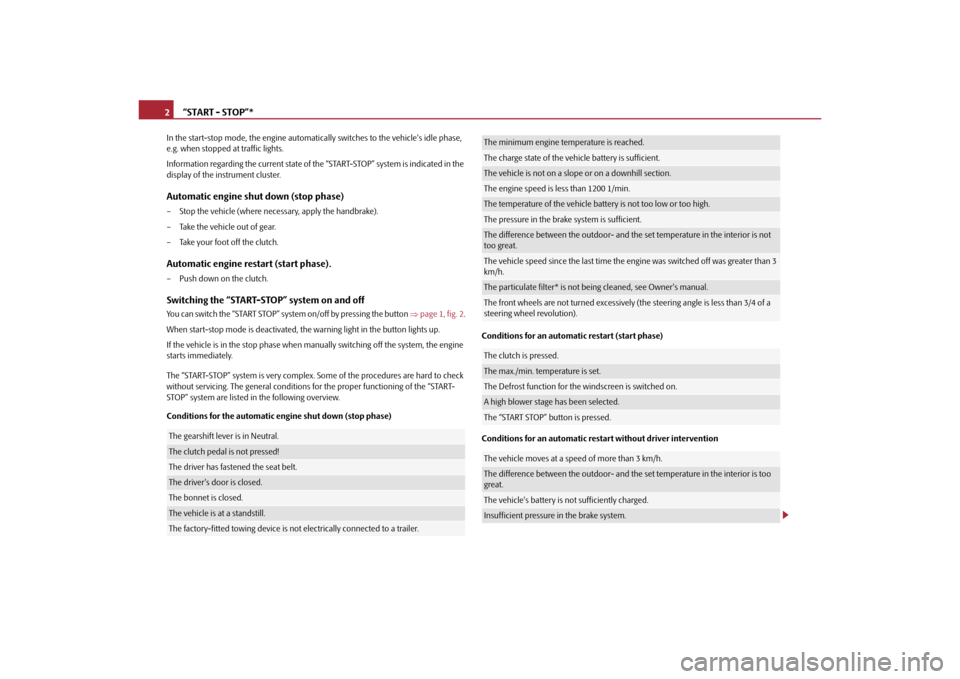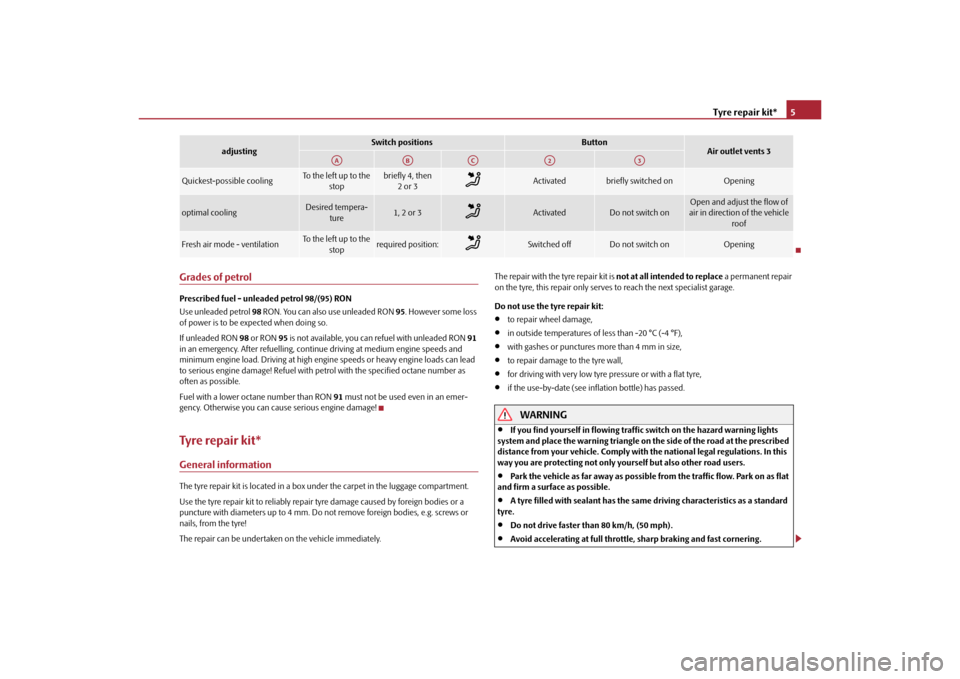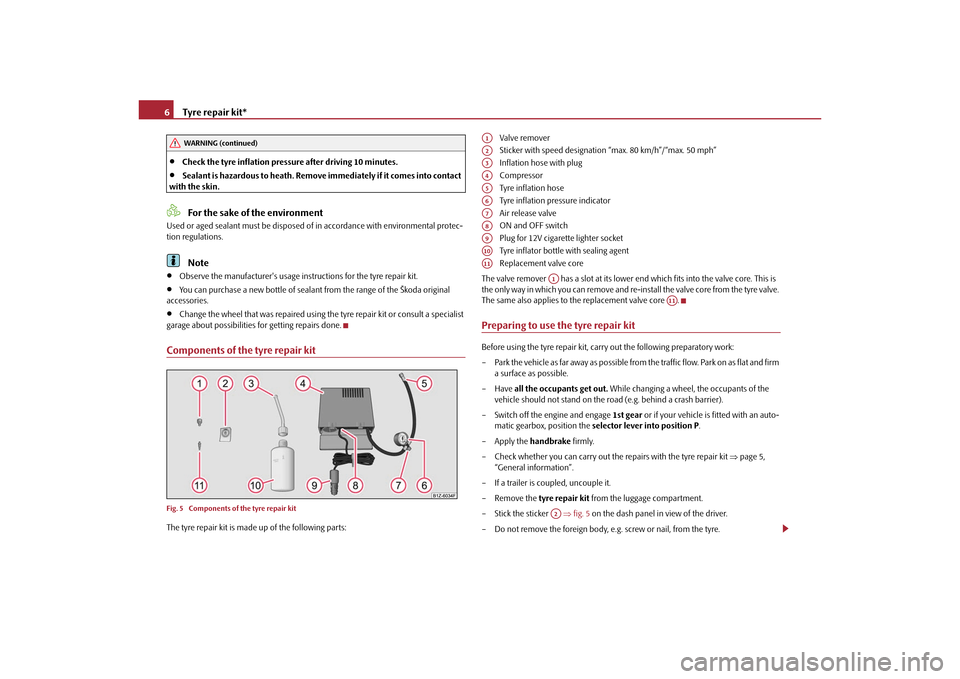wheel SKODA OCTAVIA 2010 2.G / (1Z) Technical Change
[x] Cancel search | Manufacturer: SKODA, Model Year: 2010, Model line: OCTAVIA, Model: SKODA OCTAVIA 2010 2.G / (1Z)Pages: 22, PDF Size: 0.95 MB
Page 3 of 22

“START - STOP”*
2
In the start-stop mode, the engine automatica lly switches to the vehicle's idle phase,
e.g. when stopped at traffic lights.
Information regarding the current state of th e “START-STOP” system is indicated in the
display of the instrument cluster.Automatic engine shut down (stop phase)– Stop the vehicle (where nece ssary, apply the handbrake).
– Take the vehicle out of gear.
– Take your foot off the clutch.Automatic engine restart (start phase).– Push down on the clutch.Switching the “START-STOP” system on and offYou can switch the “START STOP” system on/off by pressing the button page 1, fig. 2 .
When start-stop mode is deactivated, the warning light in the button lights up.
If the vehicle is in the stop phase when ma nually switching off the system, the engine
starts immediately.
The “START-STOP” system is very complex. Some of the procedures are hard to check
without servicing. The general conditions for the proper functioning of the “START-
STOP” system are listed in the following overview.
Conditions for the automatic engine shut down (stop phase) Conditions for an automatic restart (start phase)
Conditions for an automatic restart without driver interventionThe gearshift lever is in Neutral.The clutch pedal is not pressed!The driver has fastened the seat belt.The driver's door is closed.The bonnet is closed.The vehicle is at
a standstill.The factory-fitted towing device is no t electrically connected to a trailer.
The minimum engine temperature is reached.The charge state of the vehicle battery is sufficient.The vehicle is not on a slope or on a downhill section.The engine speed is less than 1200 1/min.The temperature of the vehicle battery is not too low or too high.The pressure in the brake system is sufficient.The difference between the outdoor- and the set temperature in the interior is not
too great.The vehicle speed since the last time the engine was switched off was greater than 3
km/h.The particulate filter* is not be ing cleaned, see Owner's manual.The front wheels are not turned excessively (t he steering angle is less than 3/4 of a
steering wheel revolution).The clutch is pressed.The max./min. temperature is set.The Defrost function for the windscreen is switched on.A high blower stage has been selected.The “START STOP” button is pressed.The vehicle moves at a speed of more than 3 km/h.The difference between the outdoor- and the set temperature in the interior is too
great.The vehicle's battery is not sufficiently charged.Insufficient pressure in the brake system.
s1ec.5.book Page 2 Friday, September 24, 2010 10:46 AM
Page 6 of 22

Tyre repair kit*5
Grades of petrolPrescribed fuel - unleaded petrol 98/(95) RON
Use unleaded petrol 98 RON. You can also use unleaded RON 95. However some loss
of power is to be expected when doing so.
If unleaded RON 98 or RON 95 is not available, you ca n refuel with unleaded RON 91
in an emergency. After refuelling, conti nue driving at medium engine speeds and
minimum engine load. Driving at high engine speeds or heavy engine loads can lead
to serious engine damage! Refuel with pe trol with the specified octane number as
often as possible.
Fuel with a lower octane number than RON 91 must not be used even in an emer-
gency. Otherwise you can ca use serious engine damage!Tyre repair kit*General informationThe tyre repair kit is located in a box und er the carpet in the luggage compartment.
Use the tyre repair kit to reliably repair tyre damage caused by foreign bodies or a
puncture with diameters up to 4 mm. Do no t remove foreign bodies, e.g. screws or
nails, from the tyre!
The repair can be undertaken on the vehicle immediately. The repair with the tyre repair kit is
not at all intended to replace a permanent repair
on the tyre, this repair only serves to reach the next specialist garage.
Do not use the tyre repair kit:
•
to repair wheel damage,
•
in outside temperatures of less than -20 °C (-4 °F),
•
with gashes or punctures more than 4 mm in size,
•
to repair damage to the tyre wall,
•
for driving with very low tyre pressure or with a flat tyre,
•
if the use-by-date (see inflation bottle) has passed.
WARNING
•
If you find yourself in flowing traffic switch on the hazard warning lights
system and place the warning triangle on the side of the road at the prescribed
distance from your vehicle. Comply with the national legal regulations. In this
way you are protecting not only yourself but also other road users.
•
Park the vehicle as far away as possible from the traffic flow. Park on as flat
and firm a surface as possible.
•
A tyre filled with sealant has the same driving characteristics as a standard
tyre.
•
Do not drive faster than 80 km/h, (50 mph).
•
Avoid accelerating at full throttle, sharp braking and fast cornering.
Quickest-possible cooling
To the left up to the stop
briefly 4, then 2or 3
Activated
briefly switched on
Opening
optimal cooling
Desired tempera- ture
1, 2 or 3
Activated
Do not switch on
Open and adjust the flow of
air in direction of the vehicle roof
Fresh air mode - ventilation
To the left up to the
stop
required position:
Switched off
Do not switch on
Opening
adjusting
Switch positions
Button
Air outlet vents 3
AA
AB
AC
A2
A3
s1ec.5.book Page 5 Friday, September 24, 2010 10:46 AM
Page 7 of 22

Tyre repair kit*
6
•
Check the tyre inflation pressure after driving 10 minutes.
•
Sealant is hazardous to heath. Remove immediately if it comes into contact
with the skin.For the sake of the environment
Used or aged sealant must be disposed of in accordance with environmental protec-
tion regulations.
Note
•
Observe the manufacturer's usage instructions for the tyre repair kit.
•
You can purchase a new bottle of sealant from the range of the Škoda original
accessories.
•
Change the wheel that was repaired using the tyre repair kit or consult a specialist
garage about possibilities for getting repairs done.
Components of the tyre repair kitFig. 5 Components of the tyre repair kitThe tyre repair kit is made up of the following parts: Valve remover
Sticker with speed designation “max. 80 km/h”/“max. 50 mph”
Inflation hose with plug
Compressor
Tyre inflation hose
Tyre inflation pressure indicator
Air release valve
ON and OFF switch
Plug for 12V cigarette lighter socket
Tyre inflator bottle with sealing agent
Replacement valve core
The valve remover has a slot at its lower end which fits into the valve core. This is
the only way in which you can remove and re-i nstall the valve core from the tyre valve.
The same also applies to the replacement valve core .
Preparing to use the tyre repair kitBefore using the tyre repair kit, carry out the following preparatory work:
– Park the vehicle as far away as possible from the traffic flow. Park on as flat and firm a surface as possible.
–Have all the occupants get out. While changing a wheel, the occupants of the
vehicle should not stand on the ro ad (e.g. behind a crash barrier).
– Switch off the engine and engage 1st gear or if your vehicle is fitted with an auto-
matic gearbox, position the selector lever into position P .
– Apply the handbrake firmly.
– Check whether you can carry out the repairs with the tyre repair kit page 5,
“General information”.
– If a trailer is coupled, uncouple it.
– Remove the tyre repair kit from the luggage compartment.
– Stick the sticker fig. 5 on the dash panel in view of the driver.
– Do not remove the foreign body, e.g. screw or nail, from the tyre.
WARNING (continued)
A1A2A3A4A5A6A7A8A9A10A11
A1
A11
A2
s1ec.5.book Page 6 Friday, September 24, 2010 10:46 AM